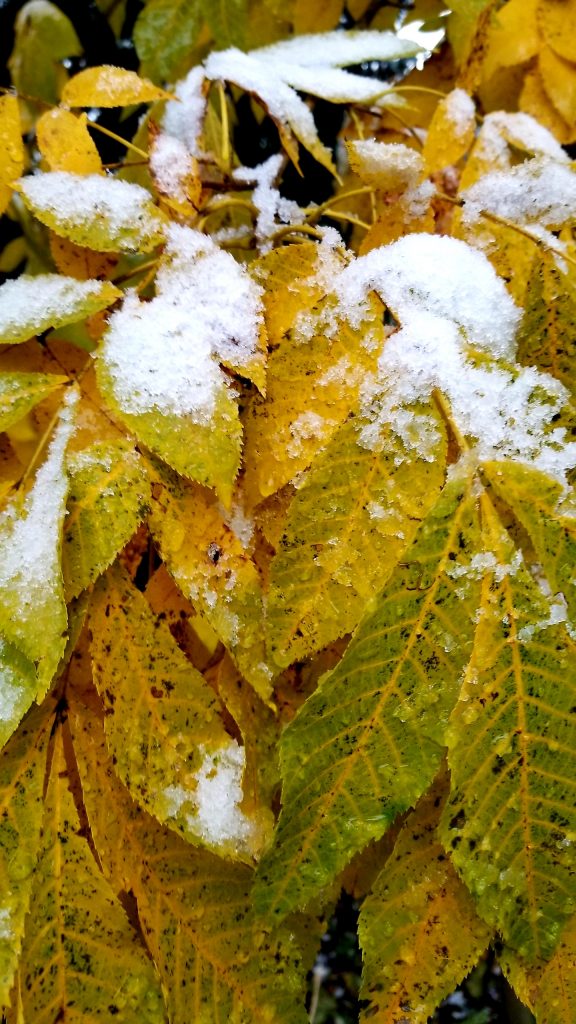A fall season like no other (except last fall?). So that’s TWO wet, cold, snowy fall seasons in a row- what is going on?
Below is a copy of an older blog from a year ago- when we had several snow events, loads of wet days, and very cold temps. Sounds like a broken record-? Fast forward to this November: already have had 2 snow events (one on Halloween), with unreal cold in late October……4 above zero in the far western suburbs.

Bitternut hickory (Carya) foliage, like so many other species-were still in leaf when the snows came, followed by single digit temps. Many trees and shrubs did not lose leaves, as they froze on the branches. Long term consequences of 2 years of freakish cold so early? TBD.
With dramatically wetter weather throughout the Great lakes region (ie: record high levels on Lake Michigan), there are also those wild temperature swings (as in early cold spells, polar vortexes etc) and early snowstorms. Much seems to be due to unusual jet streams, and climate change. And as these crazy patterns continue, we see more changes (and damage) to our tree canopy and to the natural communities ( discordant insect vs bird migrations, continually wet soils etc). On the traditional landscape plant list – the damage from early 2019 record low temps (polar vortex) killed off many plant types we have come to love (and perhaps overplant) for decades: boxwood, ornamental Asian maples, Chinese dogwood, and the list goes on…..
Conclusion: as the climate warms, we had come to accept the idea of planting species accustom to southern and warmer climes. No longer. Conjecture has it that the phenomenon known as the ‘polar vortex’ will continue in future winter months of the upper Midwest, thus knocking back, or killing off southern species. So what to do?
Perhaps sticking to native species such as *oak, hickory and other hardy northern species- the damage may be lessened? Continuing to plant tender species (Acer palm., Cornus kousa, buxus sp. etc) may be an unwise long- term plan.
* Plant oaks- help sequester carbon, cool and cleanse the air, and slow the heavier rain loads. Oaks also support more species than any other tree species. Contact us to discuss what species best suits your situation.
Below- NWS info from 2018:
PUBLIC INFORMATION STATEMENT
NATIONAL WEATHER SERVICE CHICAGO/ROMEOVILLE IL
1332 PM CST SAT DEC 1 2018
…A Look Back at the Climate for Meteorological Fall (September,
October, November) 2018 for Chicago and Rockford…
At Chicago, the average high temperature for the fall season was
59.3 degrees, which is 2.5 degrees below the 1981 to 2010 average.
The average low temperature was 44.8 degrees, which is 1.6 degrees
above normal. The mean temperature for the season was 52.1 degrees,
which is 0.4 degrees below normal.
A total of 11.68 inches of precipitation was recorded during this
past fall, which is 2.17 inches above normal. There was a total of
12.7 inches of snow recorded at Chicago, which is 11.3 inches above
normal.
Records established or tied during the fall months:
September: Record daily high temperature of 93 degrees on the 20th.
October: Record daily precipitation of 1.56 inches on the 1st.
November: Record daily precipitation of 1.20 inches on the 26th.
At Rockford, the average high temperature was 58.1 degrees, which is
3.8 degrees below normal. The average low temperature was 40.8
degrees, which is 0.3 of a degree below normal. The mean temperature
for the season was 49.4 degrees, which is 2.1 degrees below normal.
A total of 13.02 inches of precipitation was recorded during this
past fall, which was 4.42 inches above normal. In addition, a total
of 15.8 inches of snow was recorded, which is 14 Inches above normal.
Records established or tied during the fall months:
September: None.
October: Record daily precipitation of 1.65 inches on the 1st.
Record daily low temperature of 22 degrees tied on the 22nd.
Record daily precipitation of 1.36 inches on the 30th.
November: Record daily snowfall of 1.8 inches on the 9th.
Record daily snowfall of 2.1 inches on the 17th.
Record daily snowfall of 11.7 inches on the 25th.
Record Snowfall of 15.8 inches for the fall season.
(Thanks to the NWS)
